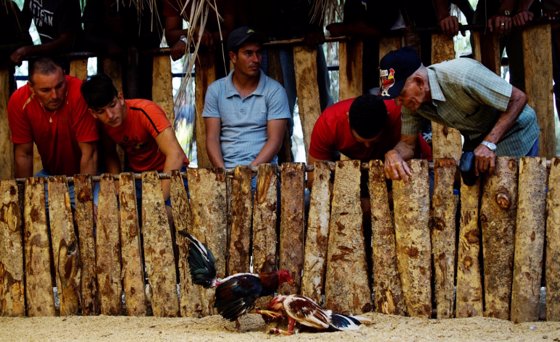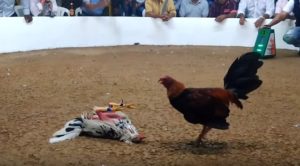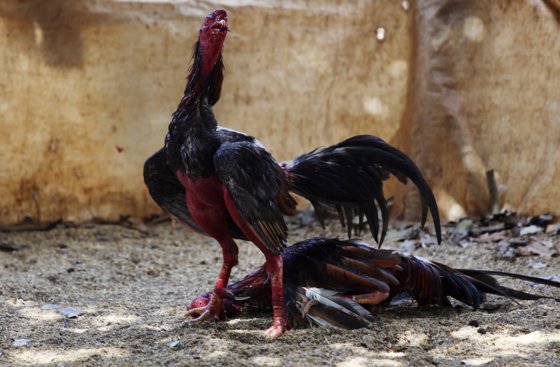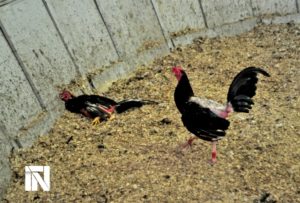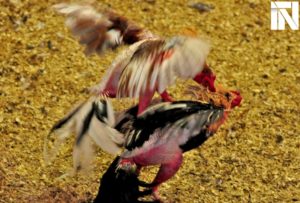PELEAS DE GALLOS EN CUBA. DESCENDENCIAS DEL GALLO CUBANO PELEADOR. PHOTOS
Las peleas de gallos en Cuba fueron prohibidas tras la Revolución de 1959, como parte de su política para impedir el juego y las apuestas. Pero luego de varios años esa medida se ha flexibilizado. Se abrieron arenas oficiales, y las vallas clandestinas se toleran siempre y cuando no existan riñas. “La gente dice: si el Gobierno permite peleas de gallos, ¿por qué nosotros no?”, sostuvo Nora García Pérez, presidenta de la Asociación Cubana para la Protección de Animales y Plantas (Aniplant).
En Cuba, las vallas (recintos semi clandestinos) donde se desarrollan las peleas, son un hervidero de gente cada vez que se inician los combates. Se puede llegar a apostar más de 2.000 dólares en medio de una atmósfera cargada de tensión, exaltación y gritos. En algunas ocasiones se suelen colar policías de paisano para evitar estas apuestas ilegales. Tampoco está permitido el acceso con ron o armas blancas.
EL HOMBRE DE BLANCO: HISTORIA DEL GALLO CUBANO Y SU DESCENDENCIA.
Es en Cuba donde nace el extraordinario castador de gallos de peleas Carlos Mendieta Montefur (1873-1960), un gran político cubano que obtiene su grado de Coronel gracias a su participación en la guerra de Independencia durante 1895-1898. Pero que además de ese rango ocupó el cargo de Diputado entre 1901-1923, así como la Presidencia de la República (1934-1935) después de que Fulgencio Batista obligara al Dr. Ramón Grau San Martín a renunciar a su cargo en la Junta de Gobierno.
El hombre de blanco (como también se le conoció al Coronel) desarrolló una línea de gallos finos de peleas conocidos como los “Mendietas”, ejemplares de pluma canela que se hicieron famosos gracias a su extraordinario coraje y valentía. De aquí se derivarían otras líneas cubanas de insuperables cualidades que comenzaron a desarrollarse en otros lugares después de la llegada de Fidel Castro al Poder en 1959 y prohibir el gobierno comunista las peleas de gallos legalmente, aunque se hace de la vista gorda muchas veces, por la popularidad que tiene en el pueblo cubano.
A raíz de la muerte del Coronel Mendieta en 1960 su pie de cría de gallos finos pasa a las manos de Gustavo Sánchez otro gran criador de gallos de peleas oriundo de Pinar del Río. Pero esta cría no puede continuar desarrollándose en la Isla de Cuba después de instaurada la Revolución Cubana, así que Gustavo Sánchez (hijo) sale de Cuba llevándose consigo 4 gallos padres y 4 gallinas que logran introducir en Estados Unidos en 1962.
De estos canelos “Mendietas” descienden los gallos “Trifino” que originaron una estirpe nueva en otros países gracias al envío de uno de ellos al Sr Rafael Rueda, y también surge el famoso “Chocolate” de Gustavo Sánchez. Respecto al origen del “Chocolate” el propio Gustavo Sánchez explica que éste se origina de un gallo canelo del Coronel llamado “Candela” mientras que su madre es la gallina #5 hija del gallino “María Andrea” que llevó el Sr Chinchín Sierra de la legendaria cría del español Paco Prida y que aún conservan en España con ese mismo nombre “María Andrea” los herederos del campeón Alejandro Moreno Lobato.
LÍNEAS DE DESCENDENCIAS DE LOS GALLOS CUBANOS
Otra línea de gallos cubanos que se desarrolló en Miami es la 4 Telas. Su fundador es René Vallé (hijo de Florentino Valle) natural de Pinar del Río, quien logró llevar a los Estados Unidos, vía México, y gracias a la intermediación del Sr José Espeleta, dos (2) gallinas cubanas entre las que destaca una jabada de la línea “Campanarios” procedente de la cría del Sr Esteban Leal.
Esta gallina jabada se cruza en Miami con el gallo “Chocolate” de Gustavo Sánchez y de aquí se originan los 4 Telas, y cuyo nombre se debe a la manera en que René Vallé marcaba sus ejemplares. Esto es, cortándole las 4 telas de los dedos, con el fin de identificarlos como suyo, pues no se usaba mucho en esa época ni las placas, ni los candados o tatuajes.
Los 4 Telas eran gallos predominantemente de pluma jabada, conocida en otros países como búlicos, moro o grillo. Aunque también los hubo cenizos (marañones) y/o zambos (colorados, rubios o indios) los que al final trascendieron en jabados o blancos gracias a la consanguinidad que se aplicó para reproducirlos.
Estos animales se conservaron en Miami desde principio de los años sesenta y a raíz de la muerte de René Vallé en 1972 pasaron a las manos de Andy Hightower, su gran amigo, y quien lo ayudó a establecerse en Miami junto con su familia después de su salida de Cuba por causa de la Revolución de Fidel Castro.
Fenotípicamente los 4 Telas fueron animales alilargos, de escaso tamaño y poco peso debido a su alto grado de consanguinidad. Pero destacaban mucho por su valentía, aun cuando su diminuto tamaño le restaba muchas oportunidades de victoria.
Después de Andy, muchos de estos animales pasaron a las manos de otros criadores, entre ellos Francisco “Paco” Rojas quien vivió en Miami durante 23 años y conocía a Andy Hightower desde 1976. Pero no es sino hasta 1988 cuando Francisco se dedica a criar los 4 Telas en su forma original conservándolos aún gracias a la consanguinidad.
LINEAS DE OTROS GALLOS CUBANOS
Otra línea de gallos cubanos es la conocida como “Los Cincuentas” o “SANTO ESPÍRITUS” procedente de Sancti Spíritus y de dónde se derivan los famosos gallinos del criador José Antonio Gómez (Jango), quien explicó en una entrevista concedida a José Batista que el origen de sus gallinos radicaba de un gallo “indio” cuyo padre había llegado a República Dominicana procedente de la Isla de Cuba, y que en una visita que hizo a dicha isla pudo averiguar los orígenes de ese gallo cubano, cuyo hijo había cruzado con algunas de sus gallinas negras y de dónde salieron sus primeros gallos gallinos, los mismos con los que ganó varias veces el título de “gallero del año” en el Coliseo de Santo Domingo.
Otro gallo de origen cubano y de gran connotación histórica en Puerto Rico desde comienzos de 1970 es el famoso “Rafelito” propiedad del Dr Tomás Peñagarincano y cuya campaña resultó súper exitosa bajo los cuidados de su gallero el Sr Ernesto Acosta mejor conocido como Chepo el Cubano. Cabe destacar que, aunque muchos boricuas consideran que este gallo “Rafaelito” es un verdadero Jefe de Raza debido a la notable descendencia que se origina de este gallo, otros en cambio cuestionan severamente la existencia de esta descendencia en otras manos, pues, era sabido que su dueño el Sr “Peña” no vendía pollos ni gallinas y mucho menos prestaba gallo alguno para la cría, y que las gallinas que llevaban a su casa para ser pisadas por el gallo “Rafaelito” terminaban pisadas por gallos chatas y no por el gran semental.
Otro gallo de origen cubano es el “Valenzuela” de dónde se deriva una de las líneas de gallos cenizos más famosas de Puerto Rico, y en torno al cual se han suscitado diversas tesis sobre su verdadero árbol genealógico, pero cuya única verdad sólo conoce su criador y su otrora gallero quienes decidieron separarse y tomar caminos diferentes. De aquí se derivan muchos gallos ganadores en torneos y eventos especiales.
De cualquier manera y al margen de cualquier especulación que pueda hacerse sobre estos magníficos ejemplares, creemos que el potencial genético de los gallos cubanos ha contribuido a la creación de muchas líneas modernas que se ha podido castar en la actualidad a conciencia de que su principal atributo ha sido el coraje y la valentía que tienen estos príncipes emplumados, independientemente de que se hayan criado en la propia Isla de Cuba o en cualquier otro sitio a donde fueron llevados por los cubanos.
COCKFIGHTING IN CUBA. DESCENDANTS OF THE CUBAN FIGHTING ROOSTER. PHOTOS
Cockfighting in Cuba was banned after the 1959 Revolution, as part of its policy to prevent gambling and betting. But after several years that measure has become more flexible. Official arenas have been opened, and clandestine fences are tolerated as long as there are no fights. “People say: if the government allows cockfighting, why not us?” said Nora García Pérez, president of the Cuban Association for the Protection of Animals and Plants (Aniplant).
In Cuba, the fences (semi-clandestine venues) where the fights take place are swarming with people every time the fighting starts. You can bet more than $2,000 in an atmosphere charged with tension, exaltation, and shouting. On some occasions, plainclothes policemen sneak in to avoid these illegal bets. Access with rum or white weapons is not allowed either.
THE MAN IN WHITE: HISTORY OF THE CUBAN ROOSTER AND ITS OFFSPRING
It is in Cuba where the extraordinary caster of fighting cocks Carlos Mendieta Montefur (1873-1960) was born, a great Cuban politician who obtained his rank of Colonel thanks to his participation in the War of Independence during 1895-1898. But that in addition to that rank, he held the position of Deputy between 1901-1923, as well as the Presidency of the Republic (1934-1935) after Fulgencio Batista forced Dr. Ramón Grau San Martín to resign from his position on the Board of government.
The man in white (as the Colonel was also known) developed a line of fine fighting cocks known as the “Mendietas”, specimens of cinnamon feathers that became famous thanks to their extraordinary courage and bravery. From here other Cuban lines of unsurpassed qualities would be derived that began to develop in other places after Fidel Castro came to power in 1959 and the communist government prohibited cockfighting legally, although it turns a blind eye many times, for the popularity it has among the Cuban people.
Following the death of Colonel Mendieta in 1960, his fine rooster breeding stock passed into the hands of Gustavo Sánchez, another great breeder of fighting cocks from Pinar del Río. But this breeding cannot continue to develop on the Island of Cuba after the establishment of the Cuban Revolution, so Gustavo Sánchez (son) leaves Cuba taking with him 4 parent roosters and 4 hens that they manage to introduce into the United States in 1962.
From these “Mendietas” canelos descend the “Trifino” roosters that originated a new lineage in other countries thanks to the sending of one of them to Mr. Rafael Rueda, and the famous “Chocolate” by Gustavo Sánchez also arises. Regarding the origin of “Chocolate”, Gustavo Sánchez himself explains that it originates from a cinnamon rooster belonging to the Colonel called “Candela” while its mother is hen #5 daughter of the hen “María Andrea” brought by Mr. Chinchín Sierra de la legendary offspring of the Spanish Paco Prida and still kept in Spain under the same name “María Andrea” by the heirs of the champion Alejandro Moreno Lobato.
DESCENDANCES OF CUBAN ROOSTERS
Another line of Cuban roosters that was developed in Miami is the 4 Telas. Its founder is René Vallé (son of Florentino Valle) a native of Pinar del Río, who managed to bring to the United States, via Mexico, and thanks to the intermediation of Mr. José Espeleta, two (2) Cuban hens, among which a pig stands out. of the line “Campanarios” from the breeding of Mr. Esteban Leal.
This jabada hen is crossed in Miami with Gustavo Sánchez’s “Chocolate” rooster and from here the 4 Telas originate, and whose name is due to the way in which René Vallé marked his specimens. That is, cutting the 4 pieces of fabric from his fingers, in order to identify them as his, since plates, padlocks, or tattoos were not widely used at that time.
The 4 Telas were predominantly jabada feather roosters, known in other countries as búlicos, moro or grillo. Although there were also ash (marañones) and/or zambos (red, blond or Indian) which in the end became jabados or white thanks to the consanguinity that was applied to reproduce them.
These animals have been kept in Miami since the early sixties and after the death of René Vallé in 1972 they passed into the hands of Andy Hightower, his great friend, who helped him settle in Miami with his family after he left. of Cuba because of the Revolution of Fidel Castro.
Phenotypically, the 4 Telas were elongated animals, small in size and light in weight due to their high degree of consanguinity. But they stood out a lot for their bravery, even if their diminutive size left them with many chances of victory.
After Andy, many of these animals passed into the hands of other breeders, including Francisco “Paco” Rojas who lived in Miami for 23 years and had known Andy Hightower since 1976. But it was not until 1988 that Francisco dedicated himself to raising The 4 Fabrics in their original form, still keeping them thanks to consanguinity.
LINES OF OTHER CUBAN COCKS
Another line of Cuban roosters is the one known as “Los Cincuentas” or “SANTO ESPÍRITUS” from Sancti Spíritus and where the famous chickens of breeder José Antonio Gómez (Jango) come from, who explained in an interview with José Batista that the The origin of his hens lay in an “Indian” rooster whose father had arrived in the Dominican Republic from the Island of Cuba, and that on a visit he made to that island he was able to find out the origins of that Cuban rooster, whose son had crossed with some of his black hens and where his first roosters came from, the same ones with which he won the title of “cockman of the year” several times at the Santo Domingo Coliseum.
Another rooster of Cuban origin and of great historical connotation in Puerto Rico since the early 1970s is the famous “Rafelito” owned by Dr Tomás Peñagarincano and whose campaign was super successful under the care of his gallero Mr. Ernesto Acosta, better known as Chepo el Cubano. . It should be noted that, although many Puerto Ricans consider that this “Rafaelito” rooster is a true Head of Breed due to the notable offspring that originates from this rooster, others, on the other hand, severely question the existence of this offspring in other hands, since it was known that its owner Mr. “Peña” did not sell chickens or hens, much less lent any rooster for breeding, and that the hens that they brought home to be trodden on by the rooster “Rafaelito” ended up trampled on by flat roosters and not by the great stallion.
Another rooster of Cuban origin is the “Valenzuela” from which one of the most famous lines of ashen roosters in Puerto Rico derives, and around which various theses have been raised about its true family tree, but whose only truth only knows its breeder and his former cockerel who decided to separate and take different paths. Many winning roosters in tournaments and special events derive from here.
In any case, and apart from any speculation that can be made about these magnificent specimens, we believe that the genetic potential of Cuban roosters has contributed to the creation of many modern lines that have been able to be bred today, knowing that their main attribute It has been the courage and courage that these feathered princes have, regardless of whether they were raised on the Island of Cuba itself or in any other place where they were taken by the Cubans.
Agencies/ Wiki/ GallosPedraglio/ GallosdelMundo/ Extractos/ Excerpts/ Internet Photos/ Arnoldo Varona/ www.TheCubanHistory.com
THE CUBAN HISTORY, HOLLYWOOD.



 COCKFIGHTING in Cuba: descendants of the Cuban Fighting Rooster. PHOTOS. * PELEAS DE GALLOS en Cuba: Descendencias del Gallo Cubano Peleador. PHOTOS.
COCKFIGHTING in Cuba: descendants of the Cuban Fighting Rooster. PHOTOS. * PELEAS DE GALLOS en Cuba: Descendencias del Gallo Cubano Peleador. PHOTOS.
